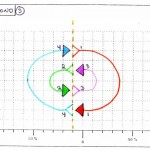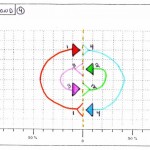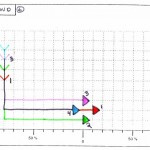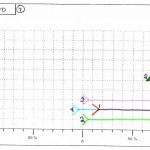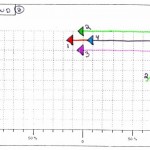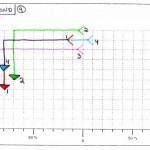In the last issue of Kitelife, I discussed modifying an existing maneuver from another team to suit your own team’s skills. This next maneuver follows that same line of reasoning.
In 1995 the Chicago Fire as a four person team flew a very interesting maneuver that showed the kites as a diamond formation. This diamond, and the kites in it, would switch positions in that diamond as they moved across the sky in a “Figure Eight” pattern. The Chicago Fire called this maneuver ‘Marching Eights’ as it did give the appearance of a group of soldiers ‘marching’ across the sky. The four kites would switch positions in the diamond through one half of the figure eight which created a compound wrap among the four. The Fire would then repeat the maneuver in ‘reverse’ on the other half of the figure eight to remove the complex wrap arrangement from their flying lines.
My team – ‘Pair of Pairs’ really liked the Fire’s maneuver, but decided that it was repeated too many times. (Four times on each side of the figure eight, and eight times total) So, I figured out the maneuver for only four ‘kite changes’ and 1/2 of a figure eight, this left a very complicated wrap in our flying lines. We experimented with this ‘unwrap’ sequence for weeks and weeks. We were successful in unwrapping only about 25% of the time and even when we completed the unwrap at the end of the diamonds, the maneuver looked ‘helter skelter’.
To solve the problem I employed a ‘training tool’ that was invented by Ron Reich back in the 80’s. Ron called his device a ‘Monkey Board’ and it’s function was to assist a team in figuring out how to wrap and unwrap lines during maneuvers visually, without actually flying them!
My ‘Monkey Board’ was constructed for me by team mate Rick Gardner. It was pretty basic (and really not pretty at all 🙂 The concept behind the device is to visually represent the flying lines of a team, and to show how the team will wrap and unwrap lines during a specific maneuver.
Rick used an old ‘coffee tray’ of metal and then attached an ‘arm’ to it. From this arm suspended above the metal tray were lengths of elastic cord (available at sewing supply store’s) The top ends were connected to the elevated arm (the fliers position) and the kites were represented by magnetics that ‘stuck’ to the metal tray.
You could then move the kites (the magnetics) through your maneuver and actually ‘look at’ the line wraps that resulted. This allowed you to calculate what each flier had to do to unwrap, without actually flying and ‘crashing’ real kites in the process!
After some ‘experimentation’ using the Monkey Board I came to the conclusion that after seeing our Diamond’s maneuver and it’s complex line wrap, the competition judges would be expecting the unwrap part at the end.
So I examined the wrap created by this maneuver and with line wrap and directions of wraps seen visually on the Monkey Board, I was able to design a maneuver the team began to call “Pre-Wrap” What we did was, in fact, loaded the line wraps into our lines prior to flying the Diamond part of the maneuver. As the team flew the maneuver they would be ‘unwrapping’ that ‘Pre-wrap’ and this would allow the team to exit from the diamonds with our lines free to continue the routine!
As was the case with the previous POP’s maneuver based on Ron Reich’s Razzle Dazzle which we named QuadraDazzle. Our variation of the Chicago Fire’s ‘Marching Eights’ was named in honor of the Fire, and we called our version FIRE DIAMOND.
- Four kites enter from the left side of the window spaced 20 ft. apart
. - 90 degree flank up in the center of the wind.
. - When #1 reaches the top of the window #1 & #3 Flank Left, #2 & #4 Flank Left (Call is: Odd-Even Flank Left!)
. - All kites travel to the outside of the window and make a down about turn. (Line up! Spacing is very critical)
.
Note: This initial ‘split’ should take place as high as possible in the window, as the entire pre-wrap maneuver tends to move downward.
- All four kites MUST arrive at the center of the window simultaneously!
. - All kites are spaced 20 ft. apart.
. - #4 kite is approx. 20 ft from the ground.
- #1 & #4 rotate ‘Clockwise’ (Circle diameter approx. 60 ft.)
. - #2 & 3# rotate ‘Counter Clockwise’ (Circle diameter approx. 20 ft.)
. - All four kites MUST arrive at the center of the window simultaneously!
- #1 & #4 rotate ‘Clockwise’ (Circle diameter approx. 60 ft.)
. - #2 & 3# rotate ‘Counter Clockwise’ (Circle diameter approx. 20 ft.)
. - All four kites MUST arrive at the center of the window simultaneously!
- #1 continues to rotate ‘Clockwise’
. - #2 falls in behind #1
. - #3 falls in behind #2
. - #4 falls in behind #3
. - In a four kite follow all kites move to the top left side of the window
and turn down at the ‘extreme left’ edge of the window.
.
Note: Fliers CANNOT move on the ground (especially forward) during diagram #’s 6 thru 8. Movement on the ground with this compound wrap, lines will lock and fliers will definitely lose control.
- At 20 ft. from the ground #1 turns left (toward the center of the window)
. - #2 & #3 turn left simultaneously (20 ft. spacing with #1 centered and 10 ft. ahead)
. - #4 turns left when 20 ft. from the ground (in line with #1)
. - SMILE (Hold the diamond formation as long as possible and ‘Show the picture’)
- At the right edge of the window #1 turns left (toward the top of the window)
. - #2 & #3 turn left simultaneously (20 ft. spacing with #1 centered and 10 ft. ahead)
. - #4 turns left and falls in line with and 20 ft. behind #1
. - SMILE (Hold the diamond formation as long as possible and ‘Show the picture’)
- At the right top of the window #1 turns left (toward the center of the window)
. - #2 & #3 turn left simultaneously (20 ft. spacing with #1 centered and 10 ft. ahead)
. - #4 turns left and falls in line with and 20 ft. behind #1
. - SMILE (Hold the diamond formation as long as possible and ‘Show the picture’)
- At the left top edge of the window #1 turns left (toward the bottom of the window)
. - #2 & #3 turn left simultaneously (20 ft. spacing with #1 centered and 10 ft. ahead)
. - #4 turns left and falls in line with and 20 ft. behind #1
. - SMILE (Hold the diamond formation as long as possible and ‘Show the picture’)
- At 20 ft. from the ground #1 turns left (toward the center of the window)
. - #2 & #3 turn left simultaneously (20 ft. spacing with #1 centered and 10 ft. ahead)
. - #4 turns left when 20 ft. from the ground (in line with #1)
.
Note: All lines are now completely unwrapped.
- From the diamond position Pair of Pairs did a ‘Star Burst’ and a Fall In Follow.
. - As all lines are clear you can continue to your next team maneuver!
FLYING NOTES
The most difficult part of flying this maneuver is the ‘Pre-Wrap’ section. If done properly the spiral formed by the fliers wrapping can be quite elegant, and become a maneuver all it’s own.
Done improperly……….. well…… you crash 😛
As noted in the description for Diagram #1 POP’s used the initial ‘odd even’ split, down about and return before entering the ‘Pre-Wrap’ sequence simply for the purposes of timing. If you make that ‘straight vertical line’ prior to entry, the wrap circles come out much ‘neater’ and are easier to accomplish! You can also begin the maneuver directly from the ‘Column Up’ with #1 & #3 turning left and #2 & #4 turning right (as in Diagram #2) BUT timing at the center is very critical, to complete the ‘Pre-Wrap’ correctly.
Concerning the Diamond section of this maneuver, once each team member gets the turn timing down this part of the maneuver is pretty simple. The difficult part is to create that ‘Picture’ of a perfect diamond formation of four fliers moving across the sky. Without the ‘Picture’ being shown the ‘Pre-Wrap’ section of this maneuver is too risky, the gain to and return for your team is too small!
Robyne Gardner made a very appropriate comment once about the ‘Difficulty of the diamond part of Fire Diamond… “After the Pre-Wrap the diamonds are easy. You get out of that terrible wrap if you do it right! It’s Freedom!”
The most difficult flier positions for the both the pre-wrap and the diamond parts of this maneuver are the #2 & #3 spots as they have all the ‘exact timing turns’ (A fact that Vicki [#2] and Robyne [#3] never let Rick [#4] and Al [#1] forget 🙂
Pair of Pairs Team devised a simple reminder call that one or the other of us would shout out while we did the diamond part of this maneuver. Just to remind us to “Make the Picture” of the diamond! Someone would call out loudly, ‘Smile’
I guess it originally meant ‘Smile for the Cameras’ or something like that. BUT the idea was to ‘hold’ the diamond as long as possible, just to give a better effect, a better overall ‘Picture’. This ‘Smiling’ would take place during both the vertical and the horizontal parts of the movement of the diamond!
Fire Diamond was one of our Class A maneuvers throughout the career of Pair of Pairs Kite Team. It showed skill in getting into and out of a compound wrap maneuver. A skill not often shown on today’s team competition fields. It was fun to fly, and it looked pretty good! We always got good scores, and frequent comments when we flew it well!
Just like QuadraDazzle I took Fire Diamond with when I helped form the six person team Shanti Air in 1998. That six person variation was called ‘Fire Arrow’ and was basically the same as Fire Diamond, only flown with only three fliers in each diamond (actually a 3 kite ‘Arrow’) of two flights (i.e. three fliers each of two flights for two side by side arrows moving across the sky)
And as far as the spectator crowd appeal, or maybe I should say the ‘Scare Factor’ of Fire Diamond. In the eyes of the ‘civilians’ the ‘Pre-Wrap’ is OBVIOUSLY tangling all four line sets of the team. My actual call for the team at the many demo’s we did to initiate that first turn into the ‘Pre-Wrap’ of Fire Diamond was to loudly yell, “Now Watch This” and the crowd always did!
The best comment I ever heard from any of those crowds was, “They’ll never get outta this one!”
I’d like to thank my team mates Vicki Romanoff and Rick and Robyne Gardner, who put up with my initial efforts and ideas to create and perform Fire Diamond! Their hard work proves that, ‘No one individual can create a team maneuver, anyone can have the idea, but the TEAM makes the final picture!
Good Winds,
AL






